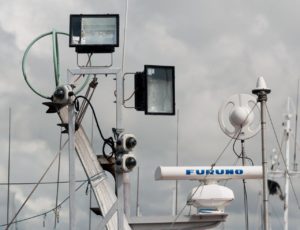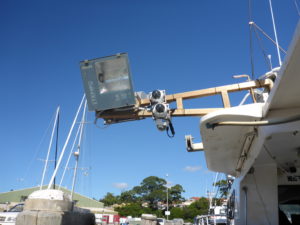This article is the first in an occasional series that we will be running on electronic monitoring in Australian fisheries.
The Australian Fisheries Management Authority (AFMA) uses the full suite of monitoring tools to support the implementation of efficient and cost-effective fisheries management consistent with the principles of ecological sustainable development while maximising the net economic return to the Australian community and being accountable to the fishing industry and the Australian community.

In 2015 AFMA implemented mandatory use of electronic monitoring (EM) in three fisheries: Australia’s Eastern and Western Tuna and Billfish fisheries (ETBF and WTBF respectively); Gillnet, Hook and Trap Fishery (GHTF); and in the Small Pelagic Fishery (SPF). The move to EM followed approximately seven years of trials, pilots and testing of EM in the fisheries, including simultaneous deployment of observers and EM, to ensure that the footage was capturing all relevant data required by the managers to manage these fisheries. Now in its eighth operational year, the EM program has proven to be an effective monitoring tool for AFMA’s fisheries managers and compliance teams.
Over the past eight years AFMA has continued to prove the efficacy of EM as a monitoring tool for fisheries management and compliance purposes. AFMA has proven EM:
- as a data collection and monitoring tool that provides verified, independent, and reliable data from those fisheries where it has been employed but that EM is one of a range of possible data collection and monitoring tools available to AFMA
- as a verification tool of fishery dependent data, such as logbooks, interactions with protected species, discarding, and crew-based data collection programs
- can replace other at-sea monitoring tools, for example observer coverage, but biological data collection continues to be supplemented by port sampling but that EM is not a panacea, that EM has limitations and that other data collection and monitoring programs are needed to collect all required fisheries data
- can support compliance monitoring, for example the use of protected species

EM equipment on a vessel’s flying bridge. (AFMA Photo) mitigation measures (e.g., torri lines) and protected species handling procedures
- that a one-size fits all approach to an independent monitoring is not going to meet AFMA’s fisheries management requirements and that EM itself is a continuum with range of options and potential set-up arrangements (e.g., still images only on nano systems, sensors only on lite systems, or full EM systems integrating cameras and sensors), and
- improved AFMA’s ability to develop and implement more discrete, targeted and ‘boat level’ management measures and/or innovative approaches to address identified risks at the fishery level (e.g., climate change or protected species mitigation measures).
Transitioning to a Standards Based Electronic Monitoring Program
The standards-based program aims to provide a reliable, flexible, adaptable, interoperable and cost-effective EM program that is responsive to the specific data needs and management objectives of individual fisheries and to independently verify fishing activities and monitor compliance. A standards based program enables AFMA to realise any advancements in AI-ML and is scalable allowing to take advantage of growth in EM domestically, regionally or globally.
AFMA’s standards based EM program continues to be data driven and data focused. EM is a data collection and verification tool, but importantly is one of a suite of monitoring tools available for AFMA to use to support the delivery of AFMA’s objectives. AFMA’s standards based EM program is being co-designed with industry with each fishery able to use EM to achieve its specific data and monitoring objectives, for example protected species monitoring or catch verification only or both. The program aims to support accountability and transparency.
AFMA will continue to use EM where appropriate for example providing independent and verified data and monitoring, while port monitoring or observer coverage will be used to collect biological data and/or data required at specified depth strata. AFMA recognises that EM cannot achieve all data collection, verification and monitoring requirements but remains a powerful tool nonetheless.
The standards based program specifically identifies the need for flexibility, adaptability and interoperability to enable each fishery to consider how EM might work in their specific situation in relation to:
- The type of system used. For example, full, lite or nano systems, which would be dependent on both the data being collected, the vessel’s specifications, cost versus the benefit provided to the specific fishery.
- What data is collected. For example, logbooks verification, TEP interaction reporting, the use of TEP mitigation measures, fishing and bycatch handling practices, spatial monitoring or various combinations of the above. This, ideally, should also be linked to how AFMA will meet the changed policies and how EM is being integrated with other monitoring tools.
- How the tool is used. For example, primary versus second data source providing the independent verification, how it is integrated with other monitoring tools.
- The compliance risk profile for the fishery, how precautionary the management and monitoring program needs to be to achieve the desired data confidence and accuracy. This is likely to link to the level of stakeholder (NGO, recreational fishers etc.) engagement in the fishery and therefore the need to be able to demonstrate compliance, monitoring and independent data collection/verification.
- Interoperability with other management systems on board the vessels and with AFMA systems, e.g., VMS, e-logs, e-CDRs.
- Adaptability to the policy and legislative obligations and to the specific needs of individual fisheries.
The program’s design is centred on the development of (a) technical standards, (b) fishery specific performance standards (FSPS) and (c) internalisation of the footage analysis/review component of the program
a: Technical Standards
AFMA is developing technical standards that will articulate the capability and minimum requirements of the EM system, hardware and maintenance requirements (articulated for example as a threshold for down time of the system for example). These are the technical specifications required from EM vendors or that industry will need to ensure their EM system is capable of.

The maintenance of the EM systems is being included in these standards to ensure that there is a reliable service being provided to industry, thereby minimising any deleterious impact of poor service to licence holders operating from remote ports.
The technical standards will need to work in concert with the FSPS and the footage analysis component to ensure the integrity of the entire program. For example, the technical standards will need to define the file format for the footage and how the footage needs to be received so that it can be ingested by AFMA’s footage review software.
Defining the technical standards enables industry to choose their own EM system and vendor. AFMA is seeking to support greater flexibility and choice to the Australian industry. As Australian industry is required to pay for their own EM systems, this approach also supports a direct relationship between the licence holder and the vendor and may improve ongoing maintenance of the system onboard the vessel.
b: Fishery Specific Performance Standards
The Fishery Specific Performance Standards (FSPS) will be drafted to be performance or outcomes focused. These standards will articulate the specific data needs (e.g., logbook verification), fishing activities (e.g., deployment of protected species mitigation measures), specific events (e.g., discards, interactions with protected species) that the EM system will need to be capable of collecting.
AFMA is moving to performance or outcomes focused standards for the EM program to support the implementation of a single EM program that can be tailored to meet the fishery specific data and monitoring needs. A performance based approach can also better account for varying vessel configurations allowing industry and vendors to install the EM system to meet these requirements while suiting the vessel too. The FSPS approach also enables the program to be scalable across a range of Commonwealth fisheries, for example tropical trawl fisheries to sub-Antarctic trap fisheries, without fundamentally changing the program itself.
c: Footage / EM Records Analysis
AFMA will be internalising the footage/EM record analysis. EM analysis may utilise existing fisheries observers or specific EM analysts or a combination of both. Utilising fisheries observers not only makes use of the skills and experience of this skilled workforce, but also creates divergent work opportunities for these AFMA employees.
The planned approach for AFMA’s footage analysis involves ingesting footage from a range of EM systems into a single footage review platform. The data generated from the analysis will also need to be incorporated into and with other empirical data sets to support evidence based and timely fisheries management decision making.
AFMA will be looking to ensure that the review software enables ongoing enhancement of the artificial intelligence and machine learning through by incorporating bounding boxes into the analysis component during the review process.
Ancillary aspects of AFMA’s EM Program
The collection of personal information (faces, boat names etc.) through the implementation of the EM program has required AFMA to address a range of ancillary issues previously not triggered by other data collection programs. This has included, privacy legislation, footage storage, system and footage ownership. These issues has required AFMA to address the legislative requirements that have been until now outside of fisheries management. These are along side well known issues of data confidentiality and data sharing for example.

AFMA has been required to undertake Privacy Impact Statements alongside the Regulatory Impact Statement processes. AFMA secured an exemption from the Commonwealth Archives Act to hold EM footage/EM records for six months. For the system ownership, this has been addressed by implementing an arrangement where AFMA requires industry to purchase their own systems and the maintenance and EM analysis are paid through industry levy’s. AFMA has obtained legal advice regarding the ownership of the footage, but to support co-management, AFMA also amended the Fisheries Management Regulations in 2019 to allow AFMA to provide the licence holder access to their own EM footage.
AFMA’s EM experience has also highlighted the opportunities to streamline monitoring tools, specifically the collection of geolocation data. Both EM systems and VMS units provide geolocation information via integrated satellite polling. Although some differences remain, for example dual polling, trials conducted by AFMA compliance teams recently have demonstrated the benefit of using EM as a geolocation data source particularly with the sensor data linked.
Claire van der Geest is General Manager, Digital Transformation and Electronic Monitoring, for the Australian Fisheries Management Authority. She welcomes your questions or comments.


